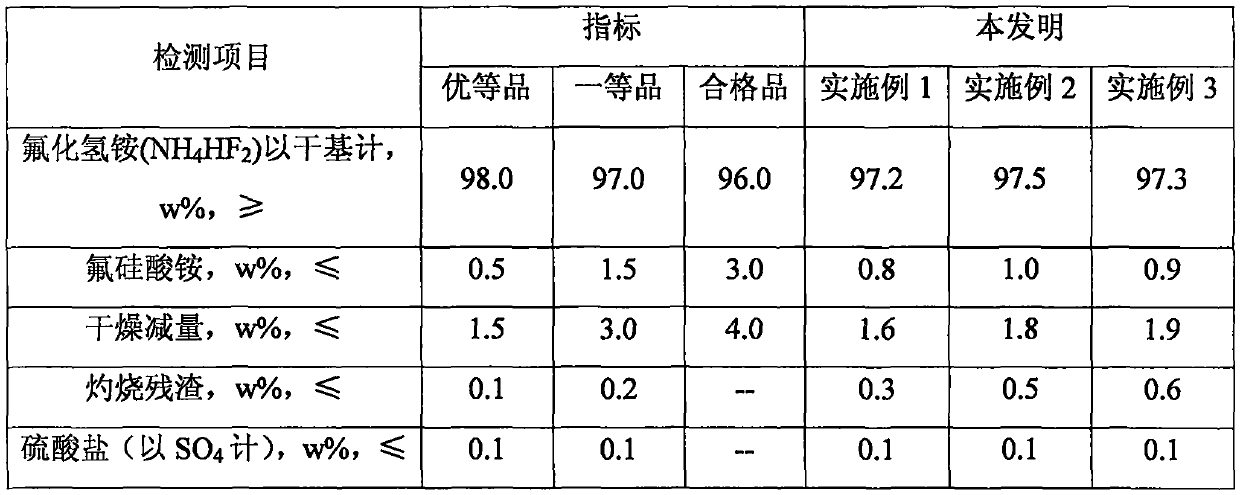Method for treating electrolytic waste residues and wastewater produced in electrolytic process nitrogen trifluoride production technology
A treatment method, nitrogen trifluoride technology, applied in water/sewage treatment, improvement of process efficiency, chemical instruments and methods, etc., to achieve recovery and comprehensive utilization, high purity, significant economic and environmental benefits
- Summary
- Abstract
- Description
- Claims
- Application Information
AI Technical Summary
Problems solved by technology
Method used
Image
Examples
Embodiment 1
[0019] Add 300kg of electrolytic waste residue and 1 ton of fluorine-containing waste water produced during the dismantling of the electrolytic cell into the neutralization kettle, stir until fully dissolved, feed ammonia water with a mass concentration of 20% to 25%, and control the reaction temperature at 35°C 45° C., until the pH value of the reaction kettle solution reaches 3, stop feeding ammonia water to obtain an ammonium bifluoride solution with a mass concentration of 18%. Add 10 g of polyferric chloride to the ammonium bifluoride solution to precipitate nickel-containing by-products, flocculate and form precipitates, and centrifuge to separate nickel-containing by-products.
[0020] Mix the obtained ammonium bifluoride solution with a mass concentration of 18% and the crystallized ammonium bifluoride mother liquor, add it to a vacuum dehydration kettle, and conduct evaporation, concentration and dehydration under the conditions of -0.086~-0.096MPa, 65~75°C until the ...
Embodiment 2
[0024] Add 400kg of electrolytic waste slag and 1 ton of fluorine-containing wastewater generated during the dismantling process into the neutralization reactor, stir until fully dissolved, feed ammonia water with a mass concentration of 20% to 25%, and control the reaction temperature at 40°C 50 DEG C, until the pH value of the reactor solution reaches 2, stop feeding ammonia water to obtain a 22% ammonium bifluoride solution with a mass concentration. Add 10 g of iron polysilicate to the ammonium bifluoride solution to precipitate, flocculate and form precipitates by-products containing nickel, and centrifuge to separate the by-products containing nickel.
[0025] Mix the obtained ammonium bifluoride solution with a mass concentration of 22% and the crystallized ammonium bifluoride mother liquor, add it to a vacuum dehydration kettle, and conduct evaporation, concentration and dehydration under the conditions of -0.086~-0.096MPa, 65~75°C until the ammonium bifluoride The co...
Embodiment 3
[0029] Add 500kg of electrolytic waste slag and 1 ton of fluorine-containing waste water produced during the dismantling process into the neutralization reactor, stir until fully dissolved, feed ammonia water with a mass concentration of 20% to 25%, and control the reaction temperature at 20°C 35° C., until the pH value of the reaction kettle solution reaches 4, stop feeding ammonia water to obtain an ammonium bifluoride solution with a mass concentration of 26%. Add 10 g of polyferric sulfate to the ammonium bifluoride solution to precipitate nickel-containing by-products, flocculate and form precipitates, and centrifuge to separate nickel-containing by-products.
[0030] Mix the obtained ammonium bifluoride solution with a mass concentration of 26% and the crystallized ammonium bifluoride mother liquor, add it to a vacuum dehydration kettle, and conduct evaporation, concentration and dehydration under the conditions of -0.086~-0.096MPa, 65~75°C until the ammonium bifluoride ...
PUM
 Login to View More
Login to View More Abstract
Description
Claims
Application Information
 Login to View More
Login to View More - Generate Ideas
- Intellectual Property
- Life Sciences
- Materials
- Tech Scout
- Unparalleled Data Quality
- Higher Quality Content
- 60% Fewer Hallucinations
Browse by: Latest US Patents, China's latest patents, Technical Efficacy Thesaurus, Application Domain, Technology Topic, Popular Technical Reports.
© 2025 PatSnap. All rights reserved.Legal|Privacy policy|Modern Slavery Act Transparency Statement|Sitemap|About US| Contact US: help@patsnap.com


